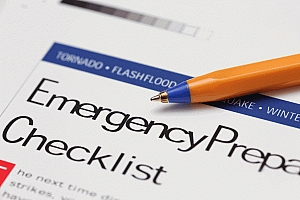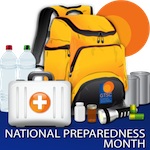When Businesses Encourage Family Preparedness, Community Resilience Improves
Your business continuity plan could be compromised if your employees and their families are unprepared to keep their families and pets safe after a disaster. According to a 2012 poll by Adelphi University Center for Health Innovation, almost half of all Americans have no family disaster plan or supplies, making it very likely that some of your employees are unprepared.
Preparedness Gaps
- 44% of Americans do not have a first-aid kit.
- 48% of Americans do not have emergency supplies.
- 42% of Americans don’t know the phone numbers of immediate family members.
Improving the Speed of Recovery
In order to return to normal as soon as possible after a disaster, communities need businesses open and employees at work. That’s why it’s vital that you work with employees, especially any that are essential for business continuity and resilience, to develop a family preparedness plan.
Most of the 48% of Americans without emergency supplies think it’s a good idea to have supplies and a plan, but they keeping putting it off. By incorporating family preparedness into the culture of preparedness you promote for the business, you provide people with information and a framework to make emergency planning a priority at home and at the office.
5 Ways to Encourage Employees to Develop a Family Emergency Plan
- Hand out checklists that employees can take home to make sure they have everything needed in an emergency.
- Distribute information about family preparedness as part of new employee orientation and post useful links on the company intranet.
- Conduct a lunchtime training session about family preparedness, where people can ask questions and share ideas.
- During your annual (or more frequent) business continuity planning review, send a reminder to employees and include the checklists and links. Remind everyone to inspect family go-kits for expired items.
- Ask any employees who are essential to your business continuity plan to confirm that they have a family plan and emergency supplies.
Strengthen your business continuity planning by encouraging family preparedness for your employees. Everyone will be better off for it.
Contributing Author
 Lilly Harris is the CEO of MSA, Inc., a small, economically disadvantaged, woman-owned small business that delivers expertise and knowledge in Professional Services, Systems Test Evaluation and Support, and Emergency Management to more than thirty federal and commercial clients.
Lilly Harris is the CEO of MSA, Inc., a small, economically disadvantaged, woman-owned small business that delivers expertise and knowledge in Professional Services, Systems Test Evaluation and Support, and Emergency Management to more than thirty federal and commercial clients.



 Turn on the news following a mass shooting and the witness describe the same scene: people barricading themselves in rooms, hiding under tables, scrambling for shelter as a shooter stalks through the building.
Turn on the news following a mass shooting and the witness describe the same scene: people barricading themselves in rooms, hiding under tables, scrambling for shelter as a shooter stalks through the building.
